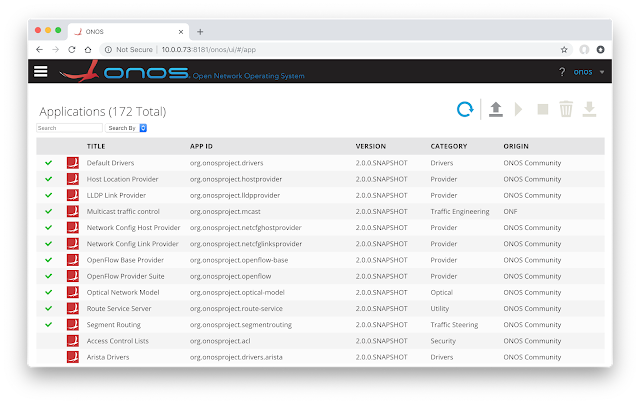Nokia Veers From Red Hat OpenStack With Latest CloudBand Update
 The latest update uses an in-house developed open source version of OpenStack that provides for more agility and a smaller footprint to support edge computing environments.
The latest update uses an in-house developed open source version of OpenStack that provides for more agility and a smaller footprint to support edge computing environments.
How a Nigerian ISP Accidentally Knocked Google Offline

Last Monday evening — 12 November 2018 — Google and a number of other services experienced a 74 minute outage. It’s not the first time this has happened; and while there might be a temptation to assume that bad actors are at work, incidents like this only serve to demonstrate just how much frailty is involved in how packets get from one point on the Internet to another.
Our logs show that at 21:12 UTC on Monday, a Nigerian ISP, MainOne, accidentally misconfigured part of their network causing a "route leak". This resulted in Google and a number of other networks being routed over unusual network paths. Incidents like this actually happen quite frequently, but in this case, the traffic flows generated by Google users were so great that they overwhelmed the intermediary networks — resulting in numerous services (but predominantly Google) unreachable.
You might be surprised to learn that an error by an ISP somewhere in the world could result in Google and other services going offline. This blog post explains how that can happen and what the Internet community is doing to try to fix this fragility.
What Is A Route Leak, And How Does One Happen?
From SDN-Washing to SDN-Hiding
 Companies are rebranding their SDN products as SD-WAN, dynamic networking, agile networking, or cloud-native network to avoid being part of the SDN hype.
Companies are rebranding their SDN products as SD-WAN, dynamic networking, agile networking, or cloud-native network to avoid being part of the SDN hype.
Dell Raises VMware Offer, Secures Binding Agreements From Shareholders
 Dell Technologies raised its offer to buy back the stock that tracks Dell’s controlling stake in VMware. Dell previously offered $109 per share. Today the company said it will pay $14 billion, or $120 per share. If shareholders approve this deal, Dell would again become a publicly traded company...
Dell Technologies raised its offer to buy back the stock that tracks Dell’s controlling stake in VMware. Dell previously offered $109 per share. Today the company said it will pay $14 billion, or $120 per share. If shareholders approve this deal, Dell would again become a publicly traded company...
Gartner Report Highlights Different Vendor SD-WAN Strategies
 The analyst firm also predicts that by 2023 more than 90 percent of WAN edge infrastructure initiatives will be based on SD-WAN.
The analyst firm also predicts that by 2023 more than 90 percent of WAN edge infrastructure initiatives will be based on SD-WAN.
Mininet, ONOS, and segment routing
Leaf and spine traffic engineering using segment routing and SDN and CORD: Open-source spine-leaf Fabric describe a demonstration at the 2015 Open Networking Summit using the ONOS SDN controller and a physical network of 8 switches.This article will describe how to emulate a leaf and spine network using Mininet and configure the ONOS segment routing application to provide equal cost multi-path (ECMP) routing of flows across the fabric. The Mininet Dashboard application running on the sFlow-RT real-time analytics platform is used to provide visibility into traffic flows across the emulated network.
First, run ONOS using Docker:
docker run --name onos --rm -p 6653:6653 -p 8181:8181 -d onosproject/onosUse the graphical interface, http://onos:8181, to enable the OpenFlow Provider Suite, Network Config Host Provider, Network Config Link Provider, and Segment Routing applications. The screen shot above shows the resulting set of enabled services.
Next, install sFlow-RT and the Mininet Dashboard application on host with Mininet:
wget https://inmon.com/products/sFlow-RT/sflow-rt.tar.gzStart sFlow-RT:
tar -xvzf sflow-rt.tar.gz
./sflow-rt/get-app.sh sflow-rt mininet-dashboard
./sflow-rt/start.shDownload the sr.py script:
wget https://raw.githubusercontent.com/sflow-rt/onos-sr/master/sr.pyStart Mininet:
sudo env ONOS=10.0.0.73 mn --custom sr.py,sflow-rt/extras/sflow.py \
--link Continue reading
LiveAction Unifies Data Sources With Network Monitoring Platform Update
 The platform integrates flow, packet, simple network management protocol, and API data sources to gain better insight into “dark environments,” including SD-WAN.
The platform integrates flow, packet, simple network management protocol, and API data sources to gain better insight into “dark environments,” including SD-WAN.
Intent Based Networking , Is it the next big thing ?
Nowadays there are some technologies which every vendor talk about. SD-WAN is very hot topic but another one is Intent Based Networking. There is always ‘ next big thing ‘ in networking. You might hear different terms , such as Self Driven Networking , Intent Driven Networking , Intent Based networking. Indeed, all […]
The post Intent Based Networking , Is it the next big thing ? appeared first on Cisco Network Design and Architecture | CCDE Bootcamp | orhanergun.net.
In Azacualpa, Honduras: “Smart Communities” Help Preserve Collective Memory

Access to the Internet can change people’s lives for the better. This is particularly true when communities take ownership of that access and take full advantage of it to improve their quality of life. This has been the case in the community of Azacualpa, a village in Intibucá in Honduras.
In Azacualpa, the members of the community took on the task of developing and implementing the project “Smart Communities” in order to reduce the digital divide – and preserve their collective memory. The project, which is part of the Internet Society’s Beyond the Net program, finds its origin in “Radio Azacualpa – The Voice of Women,” a community radio station that started in 2017.
By 2018, Smart Communities expanded its reach by impacting the nearly 400 families that inhabit the Azacualpa Valley. To achieve its objectives, the team divided the tasks into three main groups: administrative aspects, project governance, and technical aspects. The three working groups were accompanied by the Honduras Chapter of the Internet Society and the organization Sustainable Development Network Honduras (RDS-HN).
The participation of the community was fundamental. In addition to promoting a consultation with the community, the project facilitators promoted training in communications so that community Continue reading
Why SDN and IBN Demand Better Network Visibility
Automation has many positives, but also decreases NetOps’ understanding of the network. To overcome this, NetOps need tools designed to better understand, manage, and troubleshoot their infrastructure and applications.
Real-Life Network Automation: How It All Started
In spring 2018 I started collecting real-life automation wins reported by the attendees of my Building Network Automation Solutions online course. I presented them at Troopers, and as a set of network automation use cases that are available to all ipSpace.net subscribers, some of them even with free subscription.
Today let’s start with how did it start story.
Intent Based Networking , Is it the next big thing ?
Nowadays there are some technologies which every vendor talk about. SD-WAN is very hot topic but another one is Intent Based Networking. There is always ‘ next big thing ‘ in networking. You might hear different terms , such as Self Driven Networking , Intent Driven Networking , Intent Based networking. Indeed, all …
Continue reading "Intent Based Networking , Is it the next big thing ?"
The post Intent Based Networking , Is it the next big thing ? appeared first on Cisco Network Design and Architecture | CCDE Bootcamp | orhanergun.net.
Intent Based Networking , Is it the next big thing ?
Nowadays there are some technologies which every vendor talk about. SD-WAN is very hot topic but another one is Intent Based Networking. There is always ‘ next big thing ‘ in networking. You might hear different terms , such as Self Driven Networking , Intent Driven Networking , Intent Based networking. Indeed, all …
Continue reading "Intent Based Networking , Is it the next big thing ?"
The post Intent Based Networking , Is it the next big thing ? appeared first on Cisco Network Design and Architecture | CCDE Bootcamp | orhanergun.net.
The IBM-Red Hat Deal Cuts Both Ways for Canonical
 “We haven’t seen the full impact on our relationship with IBM,” said Canonical CEO Mark Shuttleworth. “IBM is still saying they want to work with us.”
“We haven’t seen the full impact on our relationship with IBM,” said Canonical CEO Mark Shuttleworth. “IBM is still saying they want to work with us.”
